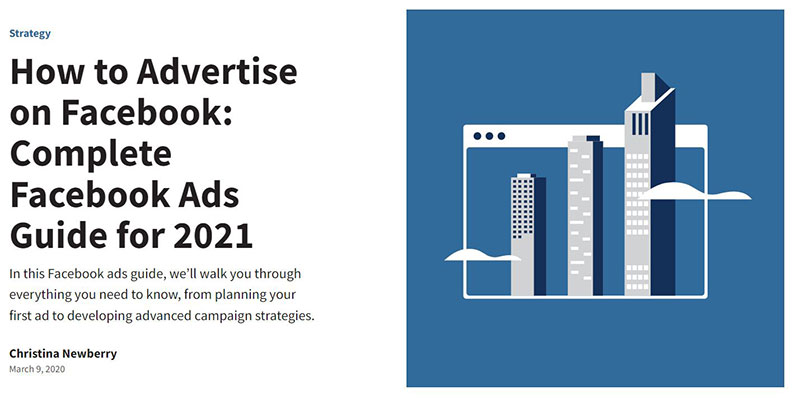A guest blog from Shane Haggerty, APR
You’ve just posted dynamic content on your school’s Facebook page. An onslaught of likes and comments is on its way, right? Not necessarily.
While school Facebook pages tend to get higher engagement because families look to those pages as destinations, the average reach of an organic post for a Facebook Page is just 5.20%, according to Hootsuite. Furthermore, Hootsuite continues, “that means roughly one in every 19 fans sees the page’s non-promoted content.”
Not happy with the amount of engagement or interest in your Facebook page compared to the amount of work you are putting into it? It may be time to consider some paid outreach, especially for content with specific goals.
Facebook advertising can be a complicated process – if you want it to be. At its heart, though, advertising on the platform is relatively simple if you break it down to these basics:
Understand the Options
One of the ways to simplify this process is not to get overwhelmed by all of the different types of ads you can purchase on Facebook. There are image ads, video ads, carousel ads, boosted posts, dynamic ads, messenger ads, and so many more. For schools, simpler is better to start with, and that is why I would recommend focusing on image ads, video ads, or boosted posts.
Boosted posts are a quick and effective way to drive engagement and views to a specific post on your page. Why recreate a separate ad when you are already creating organic content on your page? By boosting an original post, whether it is video or photos or a graphic, you will drive traffic to your page in a cost-effective way. However, there may be a specific event or message with a call to action you want to get promoted. In this instance, purchasing an image or video ad is appropriate.
Want to learn more about all of the various types of ads on Facebook? Check out this resource.
Define Your Goals
First, do you need to do any advertising? If your page generates the desired number of engagements and visits, it may not be necessary. However, keep in mind what I shared earlier about organic content and its reach. Maybe your district page is brand new and having a hard time gaining traction. A couple of weeks of boosted posts and paying for attention on the platform may be your best way to help draw interest and followers. But there are plenty of other goals you may want to achieve through Facebook. They can be broken down into three categories, according to Facebook:
Awareness Goals: Making people aware of your page, a new program, a human interest story, important information, etc. Select the Brand Awareness goal when setting up your ad if your goal is simple awareness.
Consideration Goals: These goals may involve driving traffic to your district’s website or mobile app or driving engagement, including likes and comments. Maybe you want people to watch a video or generate sign-ups for an email newsletter. Consideration goals get people to seek more information about your school district. The Traffic objective is appropriate for setting up ads to reach these consideration goals.
Conversion Goals: Conversions typically have to do with a tangible outcome like a sale. Maybe this is fundraising, ticket sales, or RSVPs to an open house event for schools. Therefore, it is essential to have a solid call to action associated with these types of ads and a connection to a landing page or website where the conversion can occur.
Keep Creative Simple
Sometimes in creating ads for Facebook, frustration or uncertainty comes in the ad creative. Facebook has certain specs that you will want to follow for creative purposes for various ad types. Remember, most people access Facebook on a mobile device, so ad creative keeps this top of mind. For a busy school PR shop without a full-time graphic designer to lean on, Canva is a savior. Canva has plenty of Facebook ad templates that take all the guesswork out of the process.
Here are some key reminders when it comes to your creative:
- Use high-resolution images.
- Put the most important information first.
- Use 2-3 short sentences maximum.
- Make sure the entire message gets seen by looking at the previews before publishing the ad.
- Make your headlines clear and concise. Brevity is honored.
Other Key Logistics
Just a few other notes to consider when it comes to Facebook advertising.
- It does work. The algorithm on Facebook is everything, and the social platform is a money-making venture, so paying to garner attention will be rewarded, like it or not.
- It is budget-friendly. This isn’t print or TV advertising where the prices are usually unreasonable. If you have a goal, Facebook will recommend a budget. From experience, you could spend as little as $50 to boost a post on your page and get tremendous results.
- It’s the targeting. Yes, the fact that you can target a specific audience makes this very effective than mass advertising in a newspaper or on the radio. You can target particular demographics or vast audiences. Heck, you can even upload your email list to target those specific people. And, if it doesn’t seem to be working, you can always stop it and rework it.
Facebook advertising can be a complex process if you let it, but its basics are simple once you give it a go focusing on these specific items. If you have specific questions about Facebook advertising for your school, feel free to reach out. My email is shane@shanehaggerty.com.
About the Author
 Shane Haggerty is a consultant for special marketing and communications projects and the owner of Haggerty Special Projects. Based in Columbus, Ohio, he has led marketing and PR for several school districts and led consulting projects for more than 40 clients in the education and non-profit spaces for more than a decade.
Shane Haggerty is a consultant for special marketing and communications projects and the owner of Haggerty Special Projects. Based in Columbus, Ohio, he has led marketing and PR for several school districts and led consulting projects for more than 40 clients in the education and non-profit spaces for more than a decade.



